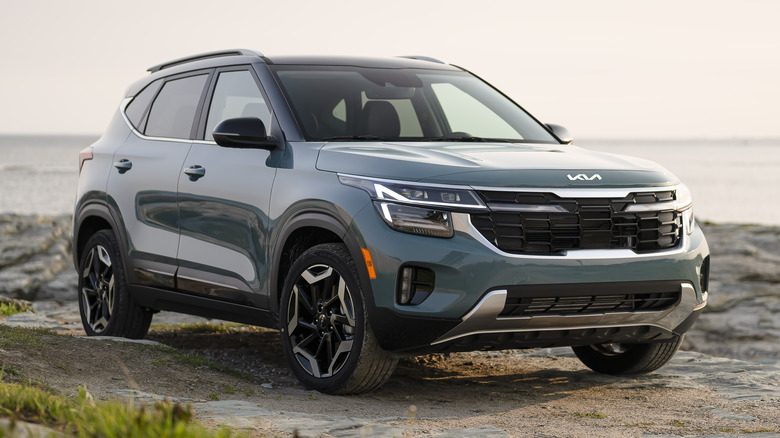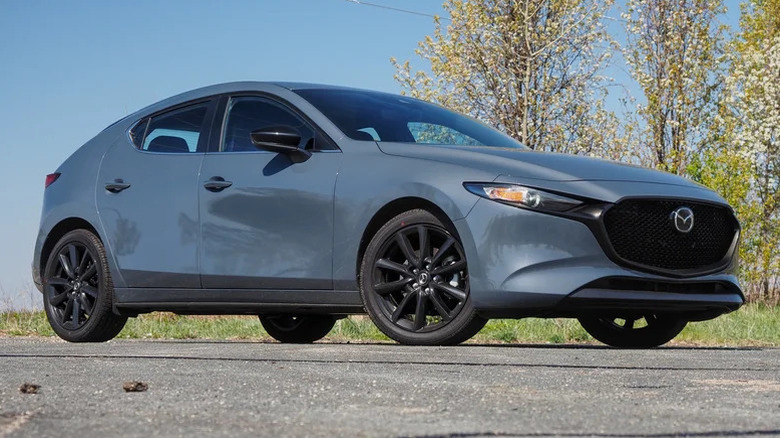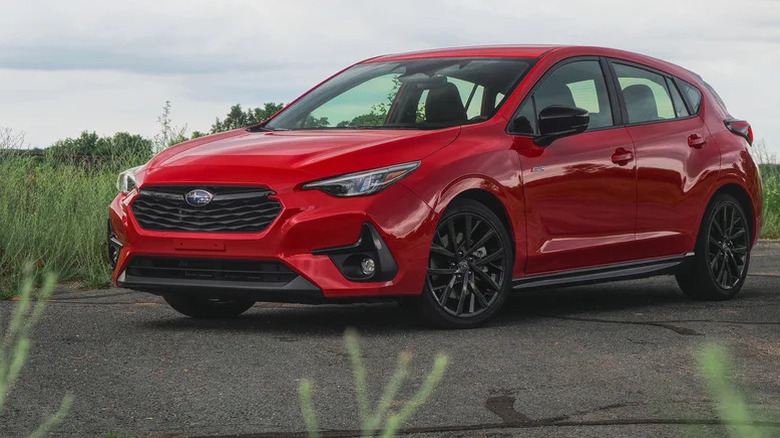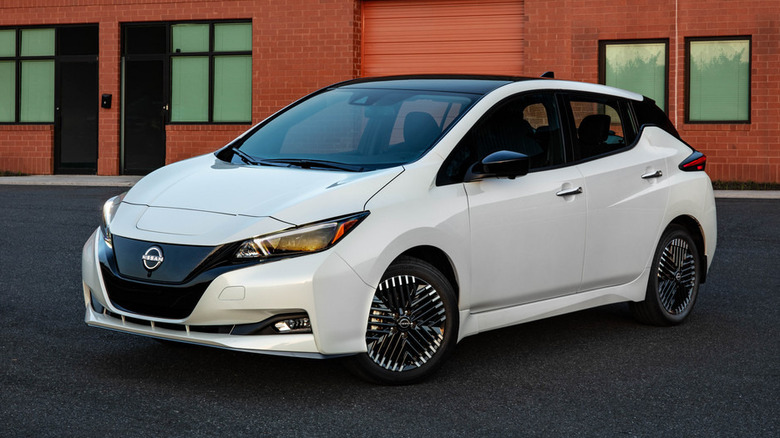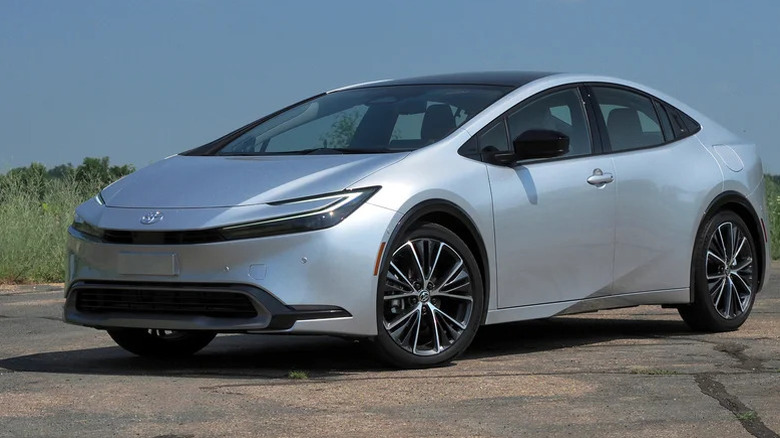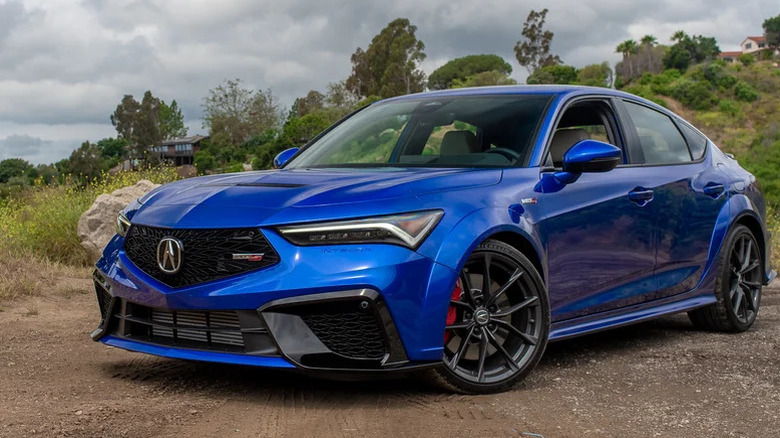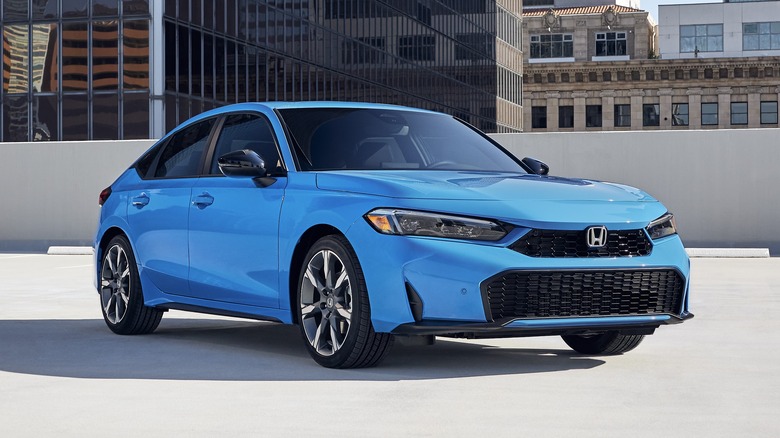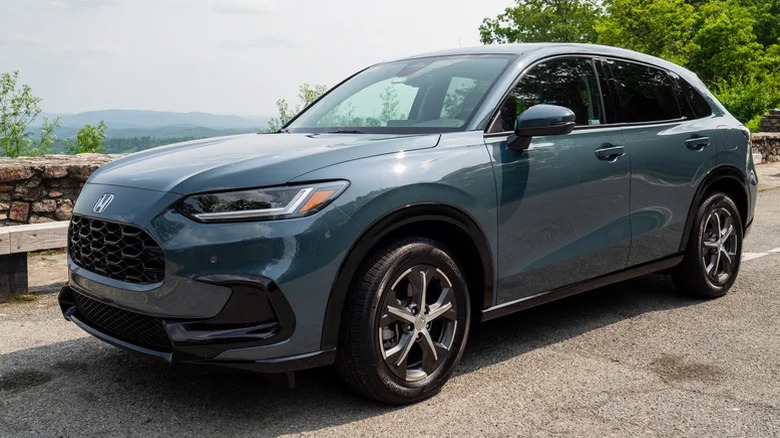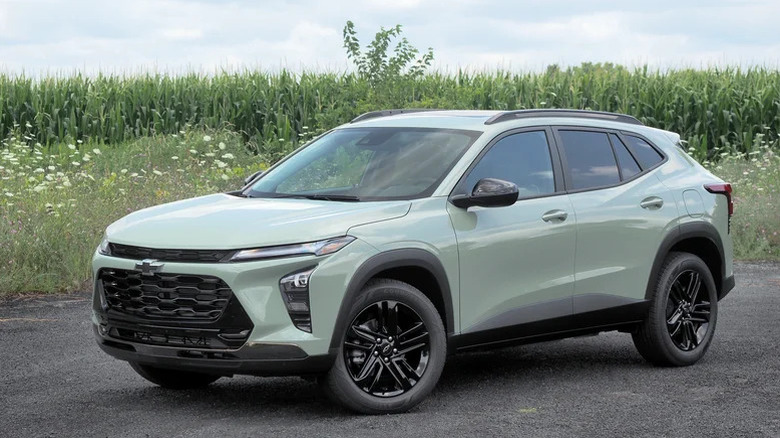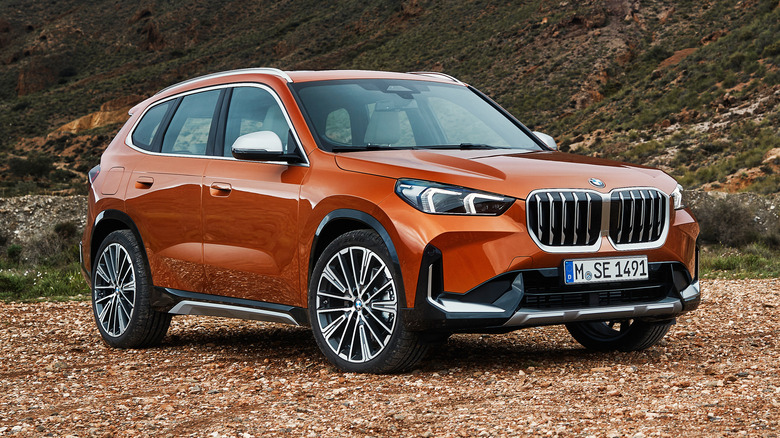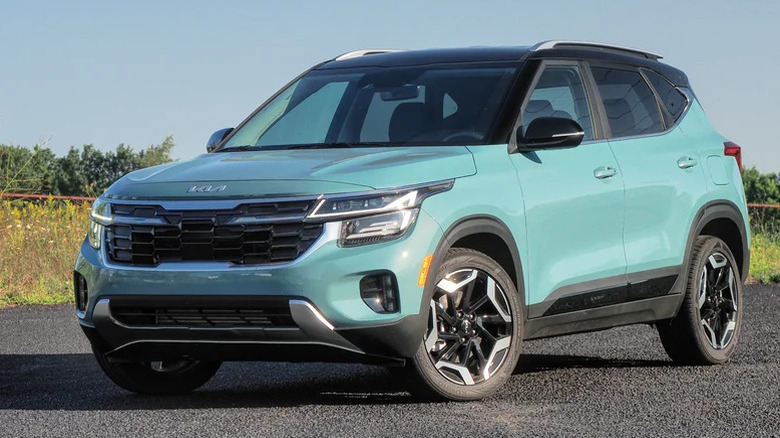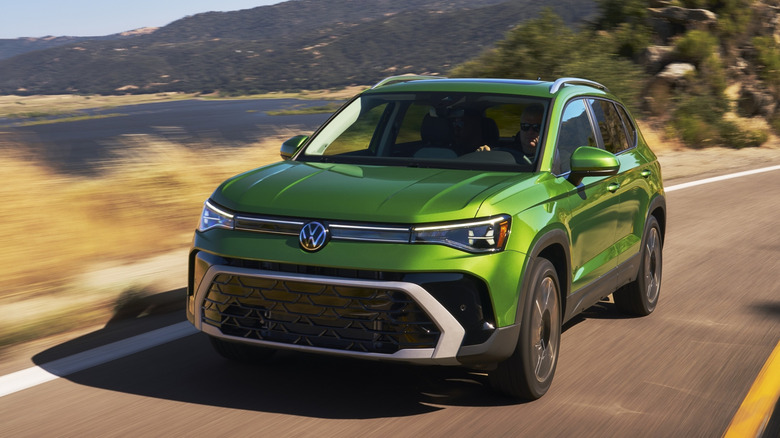12 Small Cars With The Most Trunk Space
Driving enthusiasts haven't always taken kindly to the rise of the SUV — it's a body style that prioritizes practicality over driving dynamics, and isn't inherently all that sporty, despite what the acronym implies. However, this popularity does come with plenty of benefits, one of those being that drivers looking for a roomy car now have a huge amount of choice. Smaller SUVs and crossovers are produced by virtually every mainstream manufacturer, and so there's no need to buy a huge car to get plenty of room for transporting passengers and cargo.
In fact, some of the smallest SUVs and crossovers offer cargo capacity comparable to much larger sedans, and modern hatchbacks give some of them a run for their money too. These 12 SUVs, crossovers, and hatchbacks cover a broad spectrum of manufacturers and price points, but each offers more than 20 cubic feet of cargo capacity within a compact overall footprint.
Mazda Mazda3 — 20.1 cubic feet
Offering generous trunk space given its size, the Mazda3 is a hatchback for drivers who need more practicality than a Miata but don't want to give up on driver enjoyment. SlashGear put the current generation Mazda3 through its paces back in 2023 and gave it high marks, citing its high interior quality levels, ample power, and enjoyable handling as particularly praiseworthy points. The car is also available with a manual transmission, although only in certain configurations.
As well as being comfortable and fun to drive, the Mazda3 is competitively sized inside too. With all the seats up, the car offers 20.1 cubic feet of trunk space, but the rear row also folds down to provide added capacity for transporting particularly bulky items. When the seats are up, rear-seat passengers won't be left wanting either, as we found the Mazda3's headroom to be generous enough for adults. It might not have the absolute best cargo space in its segment, but given the car's other charms, there's a lot to like for its price.
Subaru Impreza — 20.4 cubic feet
Beating the Mazda3 on trunk space by the smallest of margins is the Subaru Impreza, which offers 20.4 cubic feet of space behind the rear row. Much like the Mazda, the Subaru is an affordable entry point into its maker's range that delivers a decent amount of driving fun given its price. SlashGear's test vehicle arrived in the RS trim, which offers a 182 horsepower 2.5L four-cylinder engine, as well as a handful of additional safety and tech features over the base trim.
Cargo space remains unchanged across Impreza trims, as does the capacity available when the rear seats are folded down. Buyers can expect 56 cubic feet of space with those seats lowered. Much like the Mazda3, the Impreza's rear seats fold flat and are arranged in a 60/40 configuration, giving drivers some extra flexibility for prioritizing cargo, passengers, or accommodating a mix of both.
Nissan Leaf — 23.6 cubic feet
The Nissan Leaf remains one of the most affordable EVs on the market, with prices starting right around $30,000. However, there are some caveats that will likely put off some buyers. Arguably the biggest of those is the base-spec Leaf's 149 mile range, which is far behind most modern EVs. Opting for the pricier Leaf SV Plus boosts that range to 212 miles, which while still not amazing, is more acceptable for the price.
One thing buyers of the 2025 Leaf won't have to worry about is cargo capacity, which at 23.6 cubic feet, is generous considering the car's overall dimensions. In fact, overall room for both passengers and cargo is competitive, although whether future model years remain that way is unclear for now. Nissan has previously disclosed that it is working on a new generation of the Leaf with a significantly larger range, but has remained tight-lipped on exactly when it plans to launch this new design.
Audi Q3 — 23.7 cubic feet
The second generation Audi Q3 debuted back in 2018, but despite being one of the oldest crossovers in its segment, it's still competitive with what else is on the market. That includes in terms of its cargo space, which at 23.7 cubic feet is middle of the pack compared to its rivals. In other markets, Audi offers an even smaller crossover, the Q2, but in North America, the Q3 is the smallest in the brand's lineup.
Audi only offers a single powertrain for the 2025 Q3, that being a turbocharged 2.0L four-cylinder engine making 228 horsepower. It can push the car from 0-60 mph in 7.3 seconds, which is not a particularly impressive figure in the age of electrification. However, the Q3 shines in other areas — it still looks good, despite its age, and its $40,000 starting price makes it more attainable than the brand's larger, more potent SUV models.
Toyota Prius — 23.8 cubic feet
It's safe to say that no one buys a Prius solely for its cargo carrying credentials. Instead, buyers are attracted to its frugality, its reputation for reliability, and strangely enough, maybe even its looks. All previous Prius generations were far from pleasing to the eye, but the latest generation that debuted for the 2023 model year is surprisingly sleek. Even better, it doesn't compromise on any of the aforementioned core selling points of the Prius, and it's less sluggish to drive too.
SlashGear wasn't sold on the latest Prius' confusing array of dashboard buttons and switches, and its engine noises can still prove annoying under heavier acceleration. Other than that, there were few major flaws with the latest iteration of Toyota's most fuel-sipping car. Its combination of efficiency and practicality remain unchanged, although the latter has been slightly diminished thanks to the 23.8 cubic feet of trunk space, which is less than the previous generation car.
Acura Integra — 24.3 cubic feet
Much like the Toyota Prius, buyers likely won't be purchasing an Acura Integra based primarily on its luggage capacity. However, unlike the Prius, it won't be frugality that attracts them either — instead, it'll be the car's driving dynamics. The phrase driving dynamics is a little vague, but SlashGear contributor Victoria Scott better summed up the Integra's appeal in a 2024 first drive of the car when she described it as "a gift to enthusiasts."
It's precise to drive without being clinical, and engaging even at speeds that won't draw the attention of law enforcement. It's a proper drivers' car, but since it's an Acura, it's also impressively practical too. The 24.3 cubic feet of luggage space is more than some similarly priced crossovers, and the car's upscale seats ensure passengers will be able to travel in comfort. The infotainment and safety tech is also plentiful for the price, with features like lane keep assist and traffic sign recognition helping make driving that bit easier when you're not wringing the best out of the Integra through the backroads.
Honda Civic Hatchback — 24.5 cubic feet
Honda offers both a hatchback and a sedan version of the Civic, but it's the hatchback that's superior for cargo space. The 2025 model offers 24.5 cubic feet of room behind the rear seats, and since those seats fold down, bulky items can be readily accommodated too. The Japanese automaker has made a few tweaks to the Civic for 2025, including making a hybrid option available and axing the 1.5L turbocharged engine that was previously offered.
The car's exterior styling also receives small updates for the new model year, with a revised grille and front fascia. Inside, Honda's familiar cabin remains mostly unaltered, although a few new tech options are available for buyers willing to splash out on higher trims. Affordability also remains a key selling point for the latest Civic, with the base-spec trim starting just under $28,000 excluding fees and the more generously equipped Sport Touring Hybrid trim costing just under $33,000 excluding fees.
Honda HR-V — 24.5 cubic feet
Offering the same amount of cargo space as the Civic hatchback, the Honda HR-V has 24.5 cubic feet of capacity behind its rear seats. The latest generation of the HR-V debuted for the 2023 model year, offering an updated take on the small crossover formula that doesn't stray too far from Honda's core design ethos. It's practical, roomy, and decently equipped — again, much like the Civic, with which the HR-V shares a platform. Its exterior design features a grille that's more gaping than the Civic's, although it's still not as polarizing as, say, BMW or Lexus' latest grille designs.
SlashGear's reviewer noted that the HR-V was let down slightly by its CVT, which whined on the highway. However, it also no doubt played a part in the car's competitive economy figures, and it delivered power smoothly even if it wasn't the quietest while doing so. Its infotainment and safety tech is broadly comparable with rivals at its price point, which starts at $25,400 excluding fees and stretches past $30,000 for higher trims with optional extras added.
Chevrolet Trax — 25.6 cubic feet
The most affordable SUV in Chevrolet's lineup is the Trax, which starts under $23,000 including destination fee. The 2025 Trax is no simple econobox though — in fact, it doesn't look all that cheap at first glance. Both inside and out, the Trax manages to blend in with pricier crossovers, a feat helped by the fact that it borrows heavily from GM's parts bin. Even better, it offers as much cargo space as some of those pricier crossovers to boot.
The Trax boasts 25.6 cubic feet of space behind the rear rows, which expands to 54.1 cubic feet with the rear seats folded down. That makes transporting bulky or awkwardly proportioned objects less of a hassle, although it's probably not advisable to transport exceptionally heavy objects, either in the cabin or with a trailer. The Trax's 137 horsepower 1.2L three-cylinder engine works just fine for everyday urban driving, but attempt to transport any heavier cargo and the limitations of the car's modest engine will become clear.
BMW X1 — 25.7 cubic feet
BMW's smallest SUV is one of the most competitive cars in its segment for cargo space, with 25.7 cubic feet of space on offer behind the second row. Fold the second row down, and there's 57.2 cubic feet of space available. The 2025 model sees a few changes from the previous year, although they're all minor. Buyers can now spec a panoramic moonroof separately from other packages, and heated front seats are now offered on all trims. In all key respects, the car remains unchanged from when SlashGear tested it in 2023, with our reviewer at the time returning a verdict of seven out of 10.
The underwhelming performance of the xDrive28i model we drove was one reason for that middling score, as well as the several features that promised to make life easier but proved to be an inconvenience in reality. For example, our reviewer found the start/stop function to be particularly slow to respond during takeoff, and that Sport mode made no noticeable difference to the car's driving feel. It's not without its flaws then, but at least in terms of its luggage capacity, the X1 holds its own against the competition.
Kia Seltos — 26.6 cubic feet
Across much of the rest of its range, Kia punches above its weight when it comes to interior design and quality. The Seltos isn't quite as impressive in that regard, but it is a heavy hitter for its segment in other ways. The recently refreshed Seltos offers drivers admirable interior space, including 26.6 cubic feet of cargo space behind the rear row, and 62.8 cubic feet with the rear seats folded down. Those seats fold in a 60/40 configuration for added cabin layout versatility.
All-wheel drive is also offered as standard, and the tech and safety features of the Seltos are on par with what buyers expect from a Kia. That is to say, the car is well equipped for the money, although to get the best experience, buyers will need to opt for a pricier trim. Those who can live without the added niceties will find themselves with a cheap but capable SUV, with prices starting from just under $26,000 including destination fees.
Volkswagen Taos FWD — 27.9 cubic feet
In its fiercely fought segment, SlashGear's reviewer wasn't entirely convinced that the Volkswagen Taos was the best value for money on the market. Its engine is underpowered compared to its rivals, there are bits of the car that feel cheap, and it's not as refined on the road. It is, however, competitively priced, and its cargo space — at least in front-wheel drive guise — is a cut above the rest.
There's 27.9 cubic feet of room on offer for the front-wheel drive Taos, although adding all-wheel drive decreases that figure to 24.9 cubic feet. Likewise, with the rear seats folded down, the front-drive Taos has 65.9 cubic feet of space while the all-wheel drive version has 60.2 cubic feet. Buyers who can't compromise on having all-wheel drive might want to consider one of the Taos' competitors, including the Kia Seltos, which offers slightly more space although it has a similarly modest power output.
